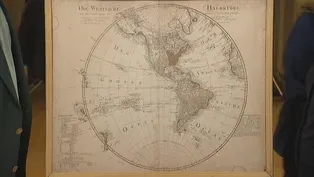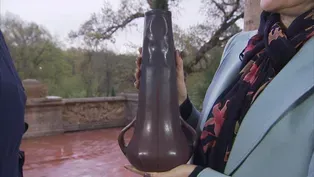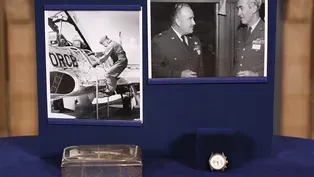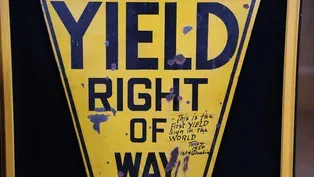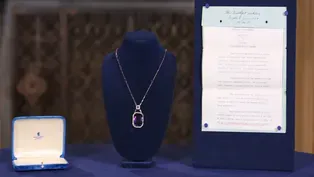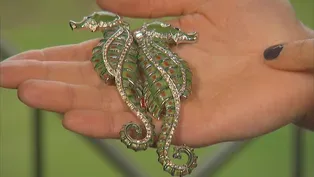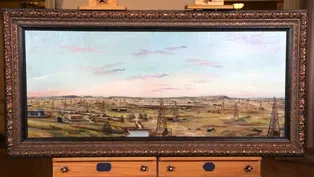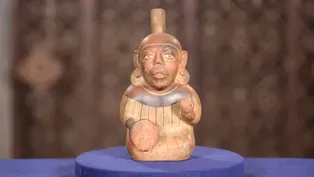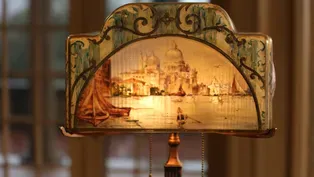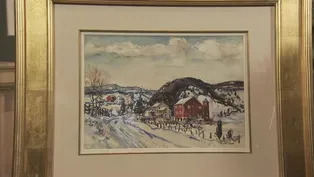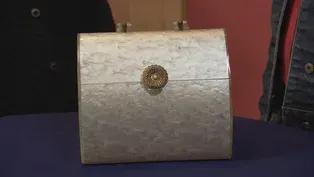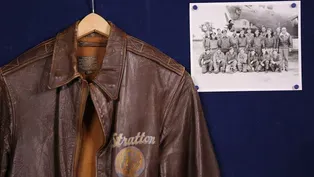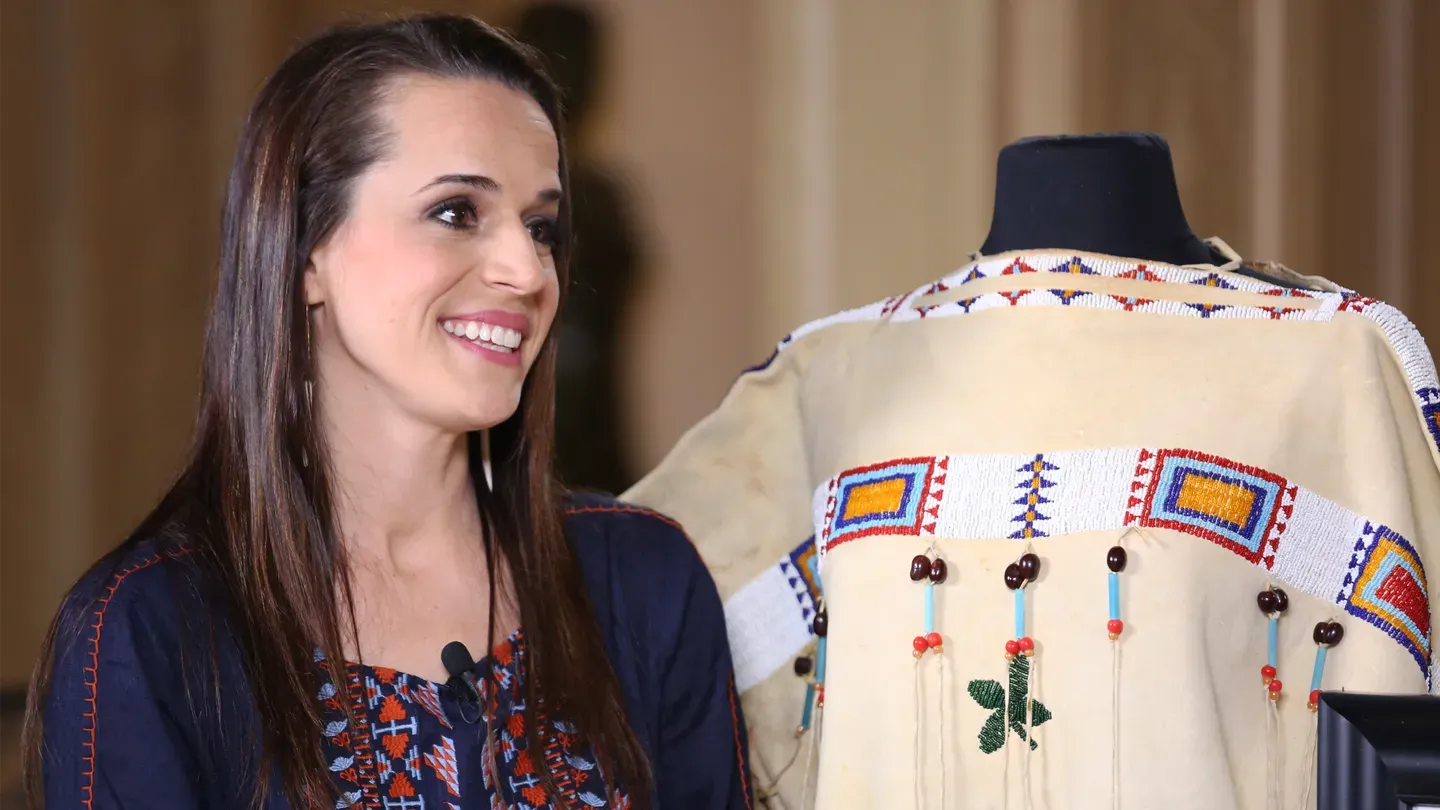

Philbrook Museum, Hour 1
Season 23 Episode 10 | 52m 29sVideo has Closed Captions
Travel to Tulsa for ROADSHOW appraisals at Philbrook Museum. Which is worth $71,000?
Travel to Tulsa for ROADSHOW treasures appraised at Philbrook Museum of Art, including a Native American rights activist archive, the first "Yield" sign with documentation, and a 1949 Model 4500 Rolex and box. Which is valued at $71,000?
Problems with Closed Captions? Closed Captioning Feedback
Problems with Closed Captions? Closed Captioning Feedback
Funding for ANTIQUES ROADSHOW is provided by Ancestry and American Cruise Lines. Additional funding is provided by public television viewers.

Philbrook Museum, Hour 1
Season 23 Episode 10 | 52m 29sVideo has Closed Captions
Travel to Tulsa for ROADSHOW treasures appraised at Philbrook Museum of Art, including a Native American rights activist archive, the first "Yield" sign with documentation, and a 1949 Model 4500 Rolex and box. Which is valued at $71,000?
Problems with Closed Captions? Closed Captioning Feedback
How to Watch Antiques Roadshow
Antiques Roadshow is available to stream on pbs.org and the free PBS App, available on iPhone, Apple TV, Android TV, Android smartphones, Amazon Fire TV, Amazon Fire Tablet, Roku, Samsung Smart TV, and Vizio.
Buy Now

ANTIQUES ROADSHOW 2025 Tour!
Enter now for a chance to win free tickets to ANTIQUES ROADSHOW's 2025 Tour! Plus, see which cities we're headed to!Providing Support for PBS.org
Learn Moreabout PBS online sponsorshipMARK WALBERG: "Antiques Roadshow" is picking the best of the best to share with you from our visit to the Philbrook Museum of Art in Tulsa.
My aunt thought that it was really creepy and it was watching her all the time, so she popped the eyes out.
(laughing): Oh, my gosh!
♪ ♪ WALBERG: Before it was a top Oklahoma cultural destination, the Philbrook Museum of Art was a home.
Villa Philbrook was commissioned by Waite and Genevieve Phillips in the roaring '20s when Tulsa was a boom town, building its reputation as the oil capital of the world.
Waite Phillips made his fortune in the oil industry, selling the company that bore his name in 1925 for $25 million.
Waite and Genevieve did what many other wealthy compatriots did, and traveled throughout the United States and Europe, developing their tastes and aspirations for their grand homes.
Villa Philbrook, completed in 1927, was one elegant result, and the Phillips family resided there for 11 years before the art museum opened in 1939.
Let's see what treasures from outside the museum have turned up today.
WOMAN: This is a bust.
I got it off of a lady for five bucks.
So, I'm here to see if she's worth anything.
MAN: This is an antique mandolin.
I'm afraid to tighten it up because I'm afraid it might break.
My son tried to play it, but we told him not to do that.
The story I got from my mom and dad, a friend of theirs, one of their relatives was a window dresser for Mason's.
My parents collected antiques, so they gave them Old Joe.
I think it's got a lot of charm.
If I saw this in an antique shop, I would expect to see a price anywhere from 75 to 150 bucks.
Right.
That's probably more than I would pay for it, but... (laughs) WOMAN: They belonged to my grandmother.
She gave them to me.
Great.
And do you know where your grandmother might have gotten them from?
I have no idea.
My grandmother was a floozy.
We have no idea where she got them.
All right, well, it sounds like your grandmother might have had the personality to wear these wonderful brooches.
So, what we have here are rhodium-, enamel- and gemstone-set Duette brooches.
A Duette brooch are a pair of brooches that are meant to be worn either separately or together.
They're made by Coro, who is arguably our country's largest and most prolific costume jewelry manufacturer from the 20th century.
They were founded in 1901 but not branded as Coro until 1943.
And it was the Coro company that trademarked the Duette name.
Hmm.
In this example here, we have the Coro signature towards the tail of one of the seahorses.
It's very faint, but it's a very characteristic C-O-R-O, the name of the company.
On the tail of the other seahorse, we have the patent number.
And you can see they have dress clip fixtures, or they would have been worn like this with an apparatus to connect them to each other.
That's no longer with the brooch, so it's kind of unfortunate it's not a part of them anymore.
Aww.
But they could still be worn together like this.
Mm-hmm.
Duette brooches in this fashion went out of style in about the 1950s when lighter knits came into fashion and you couldn't wear these heavy brooches anymore.
So, that really helps us date them to the 1940s period.
Mm-hmm.
At auction today, I would value these between $800 and $1,000.
Oh, my goodness.
Cool!
MAN: Well, I inherited it from my father.
In 1939, he was a highway patrolman who received a fellowship to the Northwestern Traffic Institute.
APPRAISER: In Chicago.
And that's in Chicago, Northwestern University.
And while there, a class assignment was to devise a public safety device.
And he came back to the class and made a presentation about "What about eliminating most stop signs "and putting up a yield, the right-of-way sign?"
Well, it was talked around the class, and of the 25 people there, 22 people thought it was a pretty dumb idea.
And even the instructor didn't think it was so great.
(laughs) And then, a war came along, and as a member of the Tulsa Police Department in 1949, he started thinking about it again.
Mm-hmm.
And in 1950, he cut out his own sign and put it up at 1st and Columbia in Tulsa.
First and Columbia was actually the intersection that had the highest number of traffic accidents in the city.
Uh-huh.
As many as three a month.
And in the nine months after the sign was planted, it dropped down to zero.
Wow.
By that time, he had nine other signs up, and there was not an accident at any of those intersections as well.
Wow.
The public didn't take it... to it too well quite at first, but after he came back with his studies, it was accepted universally.
Over here, we see that there's a "Slow" kind of a banner above this very sign.
Well, he was fearful that people wouldn't understand what they were trying to do to begin with.
Uh-huh.
So, he put the "Slow" on top of it to educate the public.
I see.
And then, after two years, they took them off all of the yield signs.
These are early renditions that he was trying to work out the design for.
Was that when he was at Northwestern University?
Yes, it was.
Okay, so those would have been in the 1939 era?
'39, '40.
Wow.
Okay.
It's just kind of neat to see how his brain is working, how the... the design of the yield sign came about.
It's kind of a... an amazing find.
I would never think of running into a yield sign and... and having it blow my mind.
I mean, this... this is a really good historical artifact here.
In my research and doing the comps, I came around to a value on this of $6,000 to $8,000 at auction.
Very good.
Thank you.
WOMAN: This is an antique car horn that was given to my great uncle by a customer who really appreciated his service while he was the service manager at the Cadillac dealership in Memphis, Tennessee.
They used it as a doorstop.
Originally, it had green glass eyes in it.
And my aunt thought that it was really creepy and it was watching her all the time, so she popped the eyes out.
Oh, my goodness!
We don't know where they are.
It's truly one of the most spectacular things I've seen at Roadshow.
It is a circa 1915 Art Nouveau silver-plated car horn in the form of a grotesque or a gargoyle.
And as you can see, it has wings, it has claws.
The horn looks like it was actually made by a music maker who would have known exactly how to bend the metal.
The workmanship here is just so spectacular.
The claws...
I can see why it might have creeped your aunt out, but it's just... it's so wonderful.
You've got this bar here where it would have been attached.
And here you would have had the horn, so you could have just reached out the window to make it sound.
It's French, probably made in Paris because Paris had the great metal foundries in the 19th and early 20th centuries.
The French love monsters.
And in the late 19th century, which was right around the time things like this started getting made, the French had what they called the Grand Guignol Theatre, which was the theater of horror.
And the themes were death, monsters, terror, and the French loved it.
Unfortunately, the eyes are missing.
But, even so, I would estimate it on today's market at between $1,500 and $3,000.
All right, great.
If it still had the eyes, you're looking at $2,000 to $4,000.
Okay.
♪ ♪ WALBERG: Oilman Waite Phillips hired Edward Buehler Delk, the Kansas City architect, in 1926, to design an Italian Renaissance villa on 25 acres of land.
Genevieve Phillips took the lead on the interior spaces, decorating rooms with furniture bought on their trips to Europe.
WOMAN: This belonged to my great-great-aunt, Ruth Muskrat Bronson.
She was a civil rights activist.
She was an author, a poet, a songwriter, an educator.
To me, she is so special.
She was a woman before her time, and she did a lot of things for Native American people that we can all still be proud of today.
What was her era, so to speak?
She was born in 1897.
This picture was taken in 1923, when she was a junior in college at Mount Holyoke.
And this is at the White House...
Okay.
...in Washington, D.C. Can you tell me some of the people in the picture?
Yes.
This is my aunt, Ruth, and this is President Calvin Coolidge.
And this is a book that she presented to him that day.
And she also gave a speech that day.
Is the dress that you're standing by the one she's wearing in that photograph?
This is the dress that's in the photograph, yes.
And... and that's the same dress that's in this photograph.
Were the moccasins and the dress created for the presidential event?
That's my understanding, yes.
They were intentionally not Cherokee items so that she could be representative of more than just her tribe and be representative of all American Indians.
This is a speech that she delivered at the White House?
Is that right?
Yes, and to read through that speech, it gives me goosebumps.
She said a lot of really amazing things in that speech.
And she said such amazing things that President Coolidge invited her to come to the White House for lunch at a later date, which she did.
When I read through her speech, in the speech, she tells who made the beadwork, who did these things.
And both the moccasins and the dress were made here in Oklahoma by Cheyenne bead workers.
The hides are brain-tan deerskin, which were never inexpensive.
They were always incredibly high-priced to get them.
They were difficult to make.
And I thought the moccasins might be Lakota because of the designs, but then I got to looking, and there's a welt right here that goes between them, between the sole and the beaded uppers.
You notice that trait in lots of Cheyenne moccasins from Oklahoma.
You know, the southern Cheyennes.
Do you know what she was talking to the president for?
Well, this was the Committee of 100 in 1923.
And I believe she was asking for civil rights for Native American people Right.
and also fighting for Native Americans in the laws that were be... being created at that time and talking about the "Indian Problem."
And she wanted the president to hear from an Indian what the real Indian problem was, and it wasn't what the other people were calling the "Indian Problem."
She wanted everyone to accept Native Americans as Americans and to allow them to be educated just like everyone else.
Yeah, I saw in the letter, she's asking for education for all.
Yes.
Where did she live?
She was from Grove, Oklahoma.
Oh, yeah.
She was my great-grandmother's sister, and that's where our whole family was from.
That's where our allotment land... we still have that allotment land.
But she... she lived in Washington, D.C. She worked there for the government, for the B.I.A.
And then she retired in Phoenix, Arizona.
She was helping different tribes her entire life.
When she passed away, I believe she was in Arizona, working for water rights for tribes out there.
Oh, yeah.
That's a big deal.
Yes.
She's asking for what we consider basic human rights Absolutely.
in this country today in the '20s.
And... and after that, you get the Depression, and things really got bleak.
Now, people have awakened to these situations, but they didn't do it without a pushback.
And that's why a lot of rules have been passed, laws have been enacted.
Everything from the Native American Sovereignty Acts to NAGPRA, the Native American Graves Protection and Repatriation Acts.
And they protect this cultural patrimony that's been handed down, in your case through your family, but also in national input.
And this was the early days of all that.
These were the people that pushed that to try to make it happen.
When you brought this dress in and the moccasins, I looked down, and I said, "Yeah, nice moccasins, nice dress."
In this condition, and mainly because they're late, if you're going to see these things at auction, you'd expect them to bring $800 to $1,200.
But that's not what's here.
That's not what this is about.
This is about... this woman wore these things to represent a panculture almost that spread across the United States, that she was fighting for, for rights for.
When you start looking at it from that point of view-- her meeting with the president, the original speech-- I think you're talking, for all that you have here-- and you have more.
You have more archival material, more photographs.
If you were to bring these up for insurance, I think it's more like $8,000 to $12,000.
Wow!
And these things are priceless to our family.
Oh, I'm sure.
♪ ♪ APPRAISER: A good subject.
People love the Rockwell Americana.
There were a lot of lithographic prints made after his paintings because he was so famous.
Right.
And that's what you have here.
Okay.
I would put it at about $700 to $800.
Awesome.
I got this painting in Amsterdam about 1972.
I just found an artist who was active during that time in the Netherlands: Pieter Dik.
And I found a comparable painting.
It had an estimate of around $800 to $1,300.
Really?
Wow.
$1,400.
So, it's possible that this could be in that same range.
That's great!
Yeah.
It's been hanging in the garage storage room.
It comes out now.
Thank you so much!
WOMAN: I brought a lamp that was my grandparents'.
As long as I could remember, it's been in our family, and then my mother's or my parents.
I didn't know really anything about it other than our family just loved it.
And my mom passed away a few years ago, and I was the one of the 11 children that ended up with it, so... Do you know where your grandparents got it?
I really don't know where they got it.
Okay.
As you see, on the side panels, it looks like a Venice scene.
Mm-hmm.
I've been looking for years to try to find one like it and hadn't seen one like it.
And so, I'd like to know just whatever we can find out about it.
Sure.
So, this is a Pairpoint puffy table lamp.
Pairpoint lamps came in three different sizes-- the table size, then there was the boudoir size, and also the candle size.
So, this is the larger size of the table size.
Pairpoint made these from about 1890 to about 1920s.
Stylistically, I would probably date this particular one from about 1900 to 1910.
Pairpoint was manufactured in New Bedford, Massachusetts, but it was retailed at different stores, and it was a luxury good at the time.
It was made for the upper classes, and they were expensive.
These were selling for upwards of $125.
Okay.
They were sold at major kind of department stores.
So, like Shreve and Co. or Tiffany & Co.
This is a, what we call, it's a blown-out and reverse-painted shade.
So, it's blown into a mold, it's acid-finished on the outside, and then enameled on the interior.
And then they put it in a kiln and re-fired it.
Now, the shades came different from the bases, so you could select your shade and you could select your base.
So, the base is probably original to this lamp, and it's a Pairpoint base, as well.
What's cool about this shade and what got me really excited about this is that this is a very rare style shade.
Okay.
Value today depends really on the shade and especially with the Venetian scenes, which were so popular.
Conservatively, we would estimate this to sell at auction between $5,000 and $7,000.
Oh, very nice.
Yeah!
I'm not going to sell it at auction, (laughing): but it's really nice to know that.
My mother would have been happy.
We had to come several years ago when Roadshow was in Tulsa, so that she could take it.
And so, I wore her sweater today so that she... would be like she was here.
MAN: I picked it up in a thrift store.
And when I got home and looked it up, I found out it's a 1902-style Van Briggle.
He passed away in 1904 from tuberculosis.
What did you pay for it?
$4.88.
It is indeed Van Briggle.
It's a little later than 1902.
It was designed just around 1902, perhaps as late as 1903, and it was made for many decades after that.
Okay.
And during the 1920s and '30s, they made a lot of this very one, the Iris vase.
I know that by the weight of the piece.
I know that because of this particular Persian rose glaze and how soft this mold is.
They used the same molds for a long time Okay.
and they would make new molds out of the old molds.
So, the longer you go, the softer it gets.
And as you could see here, it is quite soft and muddy.
Okay.
I also want to show you on the bottom.
This is what is referred to as the "dirty bottom."
"Dirty bottom" means that there is some glaze that was on the bottom.
And the dirty bottoms like this were usually done in the 1920s and '30s.
On this particular mark, you have a number 20.
The number 20 in this one is indeed the date.
This is indeed 1920.
There's a small chip inside, which is kind of dirty.
So, that chip looks like it's been there for a while.
In this condition, I would think $150 to $250 at auction is a fair price.
Okay.
In perfect condition, probably from $350 to $450.
Okay.
♪ ♪ MARK WALBERG: In 1938, the Phillips family established a non-profit corporation, and donated the 30,500- square-foot Villa Philbrook, and the grounds, to be used as a museum.
Additions to the main house over time have grown the museum to about 113,500 square feet today.
♪ ♪ This is my grandfather's on my mother's side, H. Dwayne Stratton.
He was a pilot when he was 17 in World War II, and he flew over Europe.
He did bombing raids over there, and I inherited it.
How long ago did you acquire this?
Well, I mean, I've had it for about ten years, but, I mean, I've seen it since I was a little kid.
And I probably put it on when I was in high school, but I never wore it out of the house.
This is what we call an A2 flight jacket.
They we were worn by the Army aviators starting in the 1930s.
They've reinvented these, starting in the, the 1980s.
They're wearing them again, but this is a World War II example.
From the contract label that we see in here, we're able to learn an awful lot of information about the coat.
We know, for example, that it was made by the Dubow Company in Chicago.
And, in fact, the contract number you can trace to their fourth and final contract, which started in June of 1944.
Oh, okay.
So, collectors will collect them by contract, but this one's a little better than even just a regular A2.
We love the fact that on the front here we've got his name.
We've got the insignia.
Do you know what that insignia is?
It was the 8th Air Group, or Air...
He... that's exactly right.
He was in the 8th Air Force, which flew out of England doing strategic bombing missions over Germany and occupied Europe in World War II.
But beyond that, even, just as it is, it's a good item.
It's even better in the case of your grandfather because he had it painted, which turns them from a jacket into a work of art.
They're all unique works of art, and they have different levels of interest, depending on how good the artwork is on the back.
And this is one of the better ones.
We've got the silver letters with the blue shading.
He's got a silver B-17 on there.
It's a spectacular coat.
One of the things that you brought in was a yearbook, which told us that he was in the 490th Bomb Group.
Mm-hmm.
Interesting about the 490th, they started their operational history flying out of England at about the same time that Dubow got the contract to make these jackets.
They started running bombardment missions over Germany in June of 1944.
Mm-hmm.
They supported D-Day.
They also flew missions in support of the troops, doing interdiction of German supplies during the Battle of the Bulge.
It was a good group that had, oh, I believe, over 150 operational missions and lost 22 aircraft.
We see a photograph here, too.
Do you know which one of these gentlemen was your grandfather?
He's got the lieutenant mark on his hat there, right there.
And he was a pilot?
Uh-huh.
Yeah, and he trained here in Oklahoma.
And then they sent him over to England, I guess, so...
These guys started out in B-24 Liberators in June of '44.
And then, in August of 1944, they converted to B-17s, Boeing Flying Forts.
That's what he's posing in front of there, which is a G-model Flying Fortress.
And that's also a Flying Fortress, which is... which is on the back of his leather flight jacket.
The value is in the beauty of the artwork.
Just a standard A2 is a good thing; a painted A2 is a very good thing.
This particular jacket would have a retail value between $2,000 and $2,500.
Oh, wow.
That's really nice to know.
That's great.
He'd really like that.
I really appreciate it.
WOMAN: I brought my grandmother's vase.
I think it's way older than me.
I've always loved the colors and just wanted to see what the value could be.
MAN: Brought in a... either a 1969 or 1971 Atlanta Braves team-signed baseball.
APPRAISER: We have Hank Aaron on the sweet spot, which is nice.
That being said, for collectors, they... they really look for single-signed baseballs.
It's sometimes surprising, a ball like this would sell at auction for about $150 to $200.
Oh, okay.
I think it's American, it's early 20th century, and it's made to look like gold and black enamel but is actually a base metal which has been gilded.
It's a cigar cutter.
So, the cigar goes in the end here, and then this piece comes down, gets the end off the cigar, and... and you can sit down and enjoy your afternoon.
If you're going to have to replace something like this, I'd say probably around $200, $300, something like that.
♪ ♪ WOMAN: I inherited it from my late husband.
The only thing I know about it, it was acquired at the Chicago World's Fair.
For the past 22 years, it's been in my closet.
It doesn't go with my decor.
This is a perfect example of the kind of craftsmanship that somebody would have shown at... at the World's Fair in 1893.
It kind of looks like a woman with her hands at her sides, and this is her skirt.
And, of course, there's her feet.
Mm-hmm.
I think this looks like this... the chairs that were made in Venice, almost like a shell shape.
And then, the other part of it is that those legs were all carved by hand.
And I've seen legs like that on tables from Ireland.
Okay, all right.
So, I'm thinking it's a blend of influences, and that's not unusual for that time period.
Some people refer to it as historic revival.
It's made out of oak.
It was made in a probably... a semi-factory setting, but a lot of the work was done by hand.
A thing like this, easily, I could see that being $2,000 or $3,000 in a high-end retail store.
Mm-hmm.
I have no idea about the value at all.
I know when my granddaughters were young and come to stay with me, I told them, "You behave or you're going to sit in the devil chair."
And they'd go, "Oh, Grammy, not the devil chair!"
(laughs) To this day, we call it the devil chair.
Well, that face is kind of mean looking!
It is!
WALBERG: There's much to admire on the walls of the Philbrook, but look up the ceilings when you're in the main section of the former home, and you'll see painted motifs of foliage and fanciful creatures based on Italian Renaissance designs.
WOMAN: My stepdaughter had it, and she knows I'm a huge Harry Potter nerd.
So, I offered her a $2,000 antique Oriental rug in trade... Gracious, me!
...and she took it.
Oh, lovely.
Well, it's pretty evident that you brought the fifth of the "Harry Potter" first editions, an English edition: "Harry Potter: The Order of the Phoenix."
And you've got a signed first edition.
We see the first edition marks on the back, the copyright page.
You've got a very nice book, but it needs something else.
It needs a dust jacket.
Where is that?
Well, that's at home.
It's in excellent condition, but I foolishly didn't think that you might want that also.
It's not in quite fine condition.
It's got what's known as lean and some bruising at the top and tail of the spine.
It's bowed there.
It's not fine, but I'd say it's in near fine condition.
Mm-hmm.
As it is without the dust jacket, I think it's probably $1,800 to $2,000 as a... as an auction, a realization at auction.
Okay.
If it had the dust jacket, and the dust jacket's in comparable condition, you're looking at a value of over $2,500.
MAN: I brought a oil painting, I believe, of Glenpool, Oklahoma, in approximately 1909, when the oil boom was going on in Glenpool and kind of helped create Tulsa to be what it is today.
And we believe that this painting was done by a man named Frank Treseder.
We believe that he was on his way to Dallas to see his daughter.
He stopped through Glenpool, and Robert Galbraith may have possibly had commissioned him to do this painting.
When I was just a little boy in, like, third or fourth grade, I'd go to the bank with my father, and this man that had this painting was my dad's banker.
And then, he was my banker in... later in life.
And when he got sick, I went and done some work on his house for him.
When I went in to get paid, he had this sitting on the floor in front of his fireplace.
And I said, "I remember that!"
And he goes, "I know.
You always loved that."
And so, he said, "This is what I'm paying you with."
And I was like, "I don't need a painting.
(laughing): I need dollars, you know!"
And, anyway, he said that he thought that this was worth considerable more than what he owed me for the work, that he wanted me to have this because I'd always loved it.
And so, I took it, and I took it to Salt Lake City, Utah, and then on to Ogden, Utah.
Had the museum of art up there take a look at it, and they authenticated it for me.
It's Frank McKay Treseder.
Now, he was born in Liverpool and came over to America on the ship "Chimborazo."
This was one of the famous ships that carried a lot of Mormon immigrants destined for Salt Lake City.
The artist lived from 1853 to 1923.
He's an early Mormon artist.
So, we're looking at a painting of the oil boom in... in its infancy.
Now, in Oklahoma, that started in 1905 right around Glenpool.
This could be Glenpool, and Glenpool is the place where oil was found near Tulsa.
So, it's the city that made Tulsa, in a way.
Right.
But it's not signed anywhere "Glenpool," so we can't prove it.
And there are a lot of things that... here that are a little bit speculative, but what we do know is that this painting is of an oil field, that it is by Frank Treseder.
And we also know that his paintings are held in some museums.
He's... he's a little known artist, but we do have some information about him, mostly from genealogical records and some criminal records.
He was convicted a couple times in Ogden, Utah-- I think, the first time on burglary charges and then on bribery charges to get out of polygamy charges.
Right.
So, it's very possible he became an itinerant painter after that and would have come through Tulsa when oil was found here.
The painting is oil on canvas.
While it's not dated, I would guess earlier in the history of the oil boom is when the painting would be dated-- approximately 1907, 1909, some time around then.
Have you ever had the painting appraised?
No, I have not.
I had it cleaned and she had a friend of hers look at it.
But they indicated that I would need to get a value on it from some place.
Like you said, this is from Tulsa.
This is from Glenpool.
A local appraiser would be better, and I just never had time to...
Right.
...to get it done.
There are certain things that make this painting valuable, and they might be different from what you're thinking about.
One of the things that makes it valuable is that it is of oil fields.
Now, there are not that many early oil field paintings, and you can imagine that the collector base probably has some money to spend on... on paintings of early oil fields.
Another thing that makes this painting valuable is its sheer size and beauty as a early American typographical landscape of a... of a place before it was developed.
And the third and probably even most important thing is that this is a Utah artist.
Amongst the Mormon artists, the ones who have genealogical records, they are highly collectible.
They are often times sold on... in private deals to a firm and very wealthy and established collector base of Mormon artists.
All of this together makes this painting especially valuable.
Now, there are no comparables at auction of his works because he's very rare.
My conservative auction estimate on this painting would be $15,000 to $20,000.
Really?
That is... that's awesome.
I wouldn't in...
I didn't know, like I said, I-I didn't... I-I didn't know whether it was worth the $350 to have it cleaned or not.
♪ ♪ WALBERG: Waite and Genevieve Phillips sat for these portraits at the request of the Philbrook Museum's board, after they had moved to California.
They were reluctant to do so, having concerns it would appear immodest to have the paintings on display.
Nevertheless, the works were completed by Sidney Edward Dickinson in 1945.
They now hang in the library, illuminated by the light of a globe lamp that features a reproduction of a map by Renaissance genius Leonardo da Vinci.
WOMAN: It belonged to my parents, and I'm sure they inherited it from someone further down the line.
When we were closing our parents' home after they died, my older siblings had this in the outdoor trash can.
Mm-hmm.
I didn't want anything disposed of, so I went and fetched it, and I've had it ever since.
That was about 50 years ago.
Well, it's a German map, and it was done in Nuremberg in 1797.
The cartographer's name is right up here-- Schneider-- and he would have issued several editions into the early 19th century.
And it's the Western Hemisphere, and you can see the United States very nicely highlighted with original green color.
Now, originally, that color would have been green, but they made it with copper, and the copper oxidizes over time, and it turns into that kind of brownish color.
It's before the Louisiana Purchase.
Louisiana would have been French.
And then, this is part of the Spanish New Spain.
One of the interesting things about German maps is they have a lot detail, and they were very concerned about showing what was known at the time.
And if you look at the American West up here, you can see there's virtually nothing there.
There had been a Spanish expedition that had gone up into that area, and they had heard from the Indians of the Great Salt Lake.
And you can see that there is a depiction there of that, and that's about the only information.
So, that makes it interesting because it shows the state of knowledge at the time.
German maps, generally not that decorative.
This is not that decorative, other than the shape of it.
It also has condition issues.
It's got the stains along here.
You can have that fixed, and that would enhance the value.
I would think, in a map shop, it would probably sell for... in the order about $400 to $500.
Okay, thank you very much for teaching me about the map.
Sure, absolutely.
I brought in a antique Moroccan lamp that I bought at an estate sale.
I don't think it has a terribly great amount of age.
I'd say it was made in the last 30 to 40 years in an earlier style.
There's a lot going on here.
Yeah.
As far as value goes, probably looking at, maybe around $100 or so.
Okay, great.
All right.
MAN: It was my great-grandfather's.
Before the Civil War, he worked for the consular service, and he was in Peru and Mexico studying silver mining techniques.
Then he was in Tahiti.
And he picked up things and collected them in his travels.
And then, when the Civil War broke out, he went back to California and enlisted in the Second California Cavalry.
He had a little display cabinet with things he picked up in his travels, and this was one of them.
And all my dad knew about it and what he told me was that that was Grandpa's Inca pot.
So, that was it?
That was all the information that was passed down?
That's all the information we have.
I believe he probably got it before the Civil War.
It's been in the family all that time.
Well, I can tell you, I've been doing this for 44 years, and nobody has ever said to me, "And by the way, this pre-Colombian piece was collected before the Civil War."
That's just extraordinary.
And that's really special.
First of all, the Inca would be more like 1200 to 1500 A.D.
This is actually about a thousand years before that.
Oh, really?
Yeah, this is Moche, and this is from northern Peru.
The straight spout here is typical of what we see on pieces that date from A.D. 300 to about 500.
The figure itself is very interesting.
It's clearly some sort of a warrior.
We see the shield here, and then this finger where he's pointing like this.
I suspect that he's some sort of a warrior.
This would be called a Moche stirrup vessel.
What would it have been used for?
Well, this was an object that represented this particular individual, and it might have actually been placed with him as it accompanied him to the afterlife.
Okay.
A piece like this is actually a mold-made piece.
So, it's molded.
It's not something that's modeled completely by hand.
The pigments are all the natural pigments that they get... get from plants and... and minerals.
And then, it would be burnished and fired.
Now, I'm just going to turn this thing so that the camera can see the entire piece.
And one of the things we look for on an object like this is condition.
You have a little bit of abrasion on the head.
It has a little bit of pitting.
But for something that is as old as it is, that's really extraordinary.
And you can see this very elaborate costume in the back.
I'm fascinated with the mustache.
What this indicates to me-- and this is speculation, I'll admit-- I think this possibly could be a particular individual that lived during that time, which I think is... is really exciting.
I feel, at a good auction, this is $3,000 to $5,000.
You're kidding!
No.
I think we'll put it in the china cabinet instead of on top.
This handbag was given to me by a choir member that I used to do favors for as far as picking her up for choir and attending church.
Oh, so a lady from your church gave it to you.
Yes.
It's a really lovely bag from the late 1950s, early '60s.
It's a Lucite bag in a pearlescent pattern, and it is signed right here by the manufacturer.
Wilardy was a well known name in the Lucite bag industry.
Wow.
All the hardware is brass.
It has a fabulous handle, which starts out as two separate ones and then joins at the center, so it's more comfortable when you're carrying it.
It's unusual in that it's a sort of a domed top.
Many of the earlier ones were flat tops.
So, you can get a lot more in this bag than the others.
(laughs) I would place a retail value on this bag between $300 and $400.
Wow!
So, it was a lovely gift.
Absolutely.
We have a amethyst necklace that was my husband's great-grandmother's.
I inherited it last year from my mother-in-law when she died.
All we know is that she bought it at auction in 1929 in Atlantic City.
And it was the year that Lillie Langtry died, and it's supposed to have been one of her necklaces.
She loved amethyst because we have other... like, an amethyst letter opener, amethyst rings.
She was really excited about amethyst, which I had read that Lillie Langtry also was.
Do you know how much it was paid for?
How much was paid for it?
We don't, we don't.
The... the paperwork that we had just shows that it was Lillie Langtry's, and the year that it was purchased.
Well, let's talk about Lillie Langtry.
She was born on the island of Jersey, in the Channel Islands, in 1853.
She moved to London after her first marriage in 1876.
She was an actress.
She was a socialite.
She was a social darling.
In 1877, she met the future king, Edward VII, the Prince of Wales, at a dinner party.
He maneuvered to sit next to her, and it began a relationship that lasted for many years.
They were lovers for three years, and then she got pregnant with another man's child.
Now, interestingly, Edward VII purchased a house for her in Bournemouth and actually paid for her confinement in Paris.
She ended up with property in California, and she died in Monaco in 1929.
And here in June, in 1929, Harold A.
Brand has an auction that includes her jewelry, from which your husband's great-grandmother purchased this necklace.
Right.
So, we have to ask ourselves, how does a royal piece... piece of royal provenance end up in New Jersey?
I take a look at what paperwork is represented, because provenance is very important.
Right.
But I have a couple of questions here.
And one of questions is, why is this royal piece re-mounted?
In the description, the original yellow gold mounting that Edward gave her this amethyst in-- it's a beautiful amethyst, but he gave her this amethyst in the yellow gold mounting-- has been re-mounted.
And the mounting is very contemporaneous to the late 1920s.
Oh, okay.
It's platinum, the spring ring is white gold, and all of these things are hallmarks of the 1920s.
The stone itself is very, very beautiful, but it really outshines the quality of the rest of the mounting.
Oh, okay.
According to the paperwork, it's a repurposed Victorian stone.
I have my doubts about that.
It's a really good amethyst.
It's got great qualities about it.
It's possibly Siberian.
However, it's a scissor cut.
It's a very stylistic cut from the Deco period.
So, we ask ourselves, who is Harold A.
Brown?
Let's check this out.
And, unfortunately, we find in 1949, Harold A.
Brown is brought up on conspiracy... multiple conspiracy charges.
(laughing): Oh, my goodness!
For conspiracy and fraud.
So, we have our doubts.
But, what we do have here is a really nice amethyst necklace from the Art Deco period.
Okay.
King Edward gave jewelry to his lovers and to his wife by famous makers.
This piece does not have any maker marks on it.
The mounting is platinum.
The spring ring clasp is 14-karat white gold, which puts it right at the end of the 1920s at the earliest.
What we're seeing here is a simple clamshell case, fairly commercial quality for the late 1920s.
Okay, so the case is not fancy enough, either.
(laughs) Had it been given by Edward VII to Lillie Langtry, it would be one thing.
But, nonetheless, a fair auction value is $3,000 to $5,000.
Okay, okay.
If it had royal provenance, we could double that price.
Okay.
♪ ♪ MARK WALBERG: Icons of the 1920s can be found throughout the house, with flappers dancing in the ironwork of the entrance hall, and again celebrating music itself in the music room.
WOMAN: It was from my great-grandmother.
She acquired it from her deceased brother from San Francisco, and he was there during the earthquake and fire.
And I always liked it as a... as a young girl and was always interested in it.
And no one could tell me anything about it, but I always found it very interesting.
So, this was the great earthquake of 1906.
Is this right?
I'm assuming yes, ma'am.
That was a time when a lot of objects were coming from China into the West Coast, into America.
This is a Chinese cast bronze brush pot.
Okay.
Brush pot.
Used to contain brushes that would be used for calligraphy or painting.
This is an object that was probably made in the 19th century, although it does bear a imperial mark from the Qianlong period.
That is 1735 to 1795.
However, it's a spurious mark, and so Chinese love to have things that looked like they were antique.
This has five five-clawed dragons.
Five-clawed dragons are a symbol of imperial power.
And so this would have made a great gift from one sort of wealthy merchant to another in exchange for a favor.
So it was probably made for domestic use in China around 1900.
It's a heavy piece.
It's got great weight.
It looks visually very impressive.
It's a symbol of wealth, of power, authority.
Currently, at auction, it would bring somewhere in the vicinity, we think, of between $5,000 and $8,000.
(laughing): Oh, my gosh!
I had no idea!
Gosh!
Wow!
♪ ♪ APPRAISER: Love the puppy you've brought in today.
And he is a puppet, as you well know I'm sure.
(laughter) This production started with Ganz in 1986, a nice company that made very charming pieces in today's market.
He's going to be between $125 and $175, but priceless to you.
Yes.
APPRAISER: Look how tiny they are.
They're cute, but they are baby rings.
Value-wise, there's not a ton of money there.
They're probably, at best, $10 to $15 each.
But they're cool.
WOMAN: It was too cute to throw away.
Oh, they are cute.
APPRAISER: It's definitely Dutch.
This sort of marquetry inlay is... it's what you see all over the place in Dutch furniture.
It's nice in this compact setting.
It's easier to transport, as you know, than furniture is.
This can travel with you anywhere you go, and it's of good interest to the collecting market.
I would say, if this came to auction, you might expect to see an estimate of $1,200 to $1,800.
It was something I inherited from my brother-in- law.
He lived in Philadelphia, and he bought the painting at an auction.
And he said it was painted by a local artist, and it was one of his favorite paintings.
Walter Baum is really a true Pennsylvania artist.
He was part of the Bucks County Impressionists, or sometimes called the New Hope Impressionists, and he was really one of the only artists of that group that was actually born in Bucks County.
And he stayed there his whole life.
And he was really a patron of the arts in Pennsylvania.
He was a founder at the Allentown Art Museum.
He also was a founder of the Lehigh Art Alliance.
And he started his own art school, the Baum School of Art.
Baum produced a lot of work, many say thousands of pieces.
And he did this for several decades, so it can be a bit hard to put a date on his work.
The majority of these that we see were done in the 1940s or 1950s, so that would be my best guess as to when this would have been painted.
Okay.
It is a watercolor on paper, and the white is most likely gouache, which he would've added on top of the watercolor, representing the snow.
And Baum is really best known for his snow scenes, so you kind of have what everybody wants by this artist.
A current auction estimate for this watercolor would be $2,500 to $3,500.
That's great.
Thank you.
He's my great-uncle, and he was in the Air Force, and he retired a brigadier general.
He traveled all over the world.
He was in lots of military battles, flew fighter planes all over during the war, retired to Virginia.
And he was a member of all different kinds of military organizations.
And he was in World War II also.
Yes.
And a fighter pilot in World War II.
Yes.
Out of the hundreds of items you brought, we just picked a few just to give a little theme of him.
So, tell me about the first picture here.
It's just a picture of him getting in one of his jets that he flew.
Okay.
And then this picture right here?
This is one of his commanding officers, Jimmy Stewart.
Jimmy Stewart was his commanding officer.
Yes.
And then, tell me a little bit about the box.
The box is a presentation box.
He served in the military committee for NATO, and it is dated on there for 1965 to 1967.
Okay.
And the box is sterling silver, and that would have been given as a presentation.
But the item I wanted to focus on is this watch right here.
Okay.
So, it's a Rolex.
It's a model 4500.
It's an anti-magnetic watch.
It's one of the few Rolex chronographs that only has a 30-minute registry.
This one also has a gold bezel on it.
It has luminous hands, a luminous dial.
It has a telemeter function, which was for pilots or drivers.
This particular one was built in 1949.
This would have been the highest end of what a pilot would have had.
And, of course, being a general, that would probably be the watch that he would have wanted to have had.
The collector market on early Rolexes has dramatically gone up, and originality is... is the key factor.
Underneath the rather tattered plastic original crystal is a dial that is literally unused.
It's pristine.
And in the market of rare Rolexes today, that is almost unheard of.
It is exceptionally rare to find in this condition.
And when I opened that box and-- of course, this isn't the watch that you showed me first.
No, it's not.
That was a different model Rolex-- and saw this, I was rather excited.
You didn't even know that it existed there, other than that it was another Rolex, I guess?
Yes, because the one we brought was probably his everyday watch.
Okay.
This one was just in his jewelry box.
So, any idea what the value of this watch is?
I have no idea.
At retail, the value of the box would be around $1,000, and the value of the watch would be very easily $70,000.
Oh, my gosh!
(laughing): Oh, my gosh!
It's the real deal.
If the crystal was off, that dial would just glow.
With a loop, I was able to look in through sort of the stained and... and cracked crystal to see what's under there.
And I was in shock when I realized how perfect that was.
Just an amazing piece that he left you.
Wow.
(laughs) Thank you.
Did you have any idea?
No.
(laughs): No idea?
No.
If you had the original box and the original paperwork with it, that would probably add $20,000 to the watch.
MARK WALBERG: You're watching "Antiques Roadshow" WALBERG: And now, it's time for the "Roadshow" Feedback Booth.
Brought my pin flower.
Found out it's from the 1930s.
Gentleman was more excited about the box than the pin flower.
So now I know.
I brought a 1930s Calvary sweetheart pin that my grandfather gave me for my 16th birthday, and I found out it's worth about $60 to $70.
And I've got a 1950s tether car that my grandmother gave me.
It's only worth about 50 bucks, but the memories of my grandmother giving it to me are priceless.
And, Grandma, if you're watching, I'm still a gearhead.
I brought this mummy, which I thought was a souvenir from Egypt.
Turns out it's 2,000 years old, and it's worth between $300 to $400.
Yes!
It's from 1862.
It was made in the Tower of London.
It's dated and stamped, and it was made for the federal troops.
And it's got all its parts, including the bayonet that you can take off, and the little deal that you, you know, put the... put the stuff down in there with-- I don't know, I don't know anything about guns.
But, anyway, it's legit.
It was worth between $800 and $1,200.
President Reagan and I had a great time at the Antiques Roadshow.
I've had a great evaluation, and now he's going back to the house, to go back on the shelf.
WALBERG: I'm Mark Walberg.
Thanks for watching.
See you next time on "Antiques Roadshow."
Appraisal: 1797 German Western Hemisphere Map
Video has Closed Captions
Clip: S23 Ep10 | 1m 57s | Appraisal: 1797 German Western Hemisphere Map (1m 57s)
Appraisal: 1920 Van Briggle Iris Vase
Video has Closed Captions
Clip: S23 Ep10 | 1m 53s | Appraisal: 1920 Van Briggle Iris Vase (1m 53s)
Appraisal: 1949 Model 4500 Rolex & Silver Box
Video has Closed Captions
Clip: S23 Ep10 | 3m 16s | Appraisal: 1949 Model 4500 Rolex & Silver Box (3m 16s)
Appraisal: 1950 First "Yield" Sign with Documentation
Video has Closed Captions
Clip: S23 Ep10 | 2m 26s | Appraisal: 1950 First "Yield" Sign with Documentation (2m 26s)
Appraisal: Amethyst Necklace, ca. 1925
Video has Closed Captions
Clip: S23 Ep10 | 4m 3s | Appraisal: Amethyst Necklace, ca. 1925 (4m 3s)
Appraisal: Chinese Cast Bronze Brush Pot, ca. 1900
Video has Closed Captions
Clip: S23 Ep10 | 2m 2s | Appraisal: Chinese Cast Bronze Brush Pot, ca. 1900 (2m 2s)
Appraisal: Coro Duette Seahorse Brooch, ca. 1945
Video has Closed Captions
Clip: S23 Ep10 | 2m 4s | Appraisal: Coro Duette Seahorse Brooch, ca. 1945 (2m 4s)
Appraisal: Frank M. Treseder Oil Painting, ca. 1908
Video has Closed Captions
Clip: S23 Ep10 | 4m 31s | Appraisal: Frank M. Treseder Oil Painting, ca. 1908 (4m 31s)
Appraisal: Moche Stirrup Vessel, 300-500
Video has Closed Captions
Clip: S23 Ep10 | 3m 6s | Appraisal: Moche Stirrup Vessel, 300-500 (3m 6s)
Appraisal: Pairpoint Puffy Roma Shade Table Lamp, ca 1905
Video has Closed Captions
Clip: S23 Ep10 | 2m 25s | Appraisal: Pairpoint Puffy Roma Shade Table Lamp, ca 1905 (2m 25s)
Appraisal: Walter E. Baum Landscape Watercolor, ca. 1950
Video has Closed Captions
Clip: S23 Ep10 | 1m 30s | Appraisal: Walter E. Baum Landscape Watercolor, ca. 1950 (1m 30s)
Appraisal: Wilardy Pearlized Lucite Handbag, ca. 1960
Video has Closed Captions
Clip: S23 Ep10 | 1m 6s | Appraisal: Wilardy Pearlized Lucite Handbag, ca. 1960 (1m 6s)
Appraisal: World War II A-2 Painted Flight Jacket
Video has Closed Captions
Clip: S23 Ep10 | 3m 38s | Appraisal: World War II A-2 Painted Flight Jacket (3m 38s)
Providing Support for PBS.org
Learn Moreabout PBS online sponsorshipSupport for PBS provided by:
Funding for ANTIQUES ROADSHOW is provided by Ancestry and American Cruise Lines. Additional funding is provided by public television viewers.


